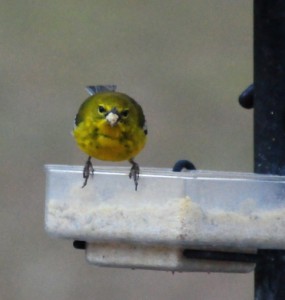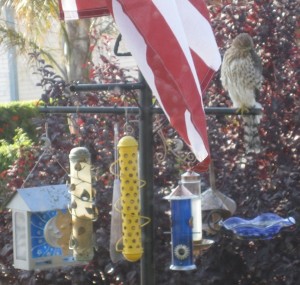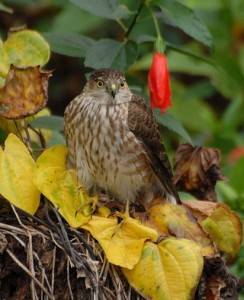-
use bird baths to attract more beaked buddies to your place
 Complete with copper dripper, the empty bird bath did have water in it. But with fast and furious action, this Robin managed to splish-splash and empty it in moments!
Complete with copper dripper, the empty bird bath did have water in it. But with fast and furious action, this Robin managed to splish-splash and empty it in moments!Constant ripples formed by the dripper function really do attract birds. The moving water grabs their attention and lures them in. Birds who never touch your feeders, and birds who never nest in houses are some birds who will visit bird baths.
Fresh water is such a great way to attract birds to your place! An unlimited supply, inexpensive, and so very simple, it’s a life source that all creatures need for survival. Although there are some real beauties out there for decorative purposes or functional art, fancy bird baths are not necessary.
On the deck, patio, tree stump, or ground, a simple plant saucer works wonders. Even placed on an up-turned flower pot, any saucer or dish filled with water will entice birds.
Keeping the water fresh is really the only requirement. And if cats roam around the yard, it’s a good idea to raise bird
 baths off the ground to give birds a bit of security. The optimal water depth for birds to bathe and wade comfortably is just 2-3 inches.
baths off the ground to give birds a bit of security. The optimal water depth for birds to bathe and wade comfortably is just 2-3 inches.Here’s a nifty accessory for converting cool pots and decorative containers into bird baths, no matter how deep the container. It’s called the Bird Bath Raft and it floats on top of the container, allowing a small amount of water onto the raft. This innovative idea makes it easier than ever to add a fresh water source for birds… enticing new visitors to your place in no time at all!
- Bird Accessories, Bird Feeders, Birding Accessories, Bluebird Feeders, Fruit, Jelly & Mealworm Feeders, Mealworm Feeder, Uncategorized, Wild Bird Feeders
The dish style mealworm feeder offers various feed options
Hey lady! What’s up with the Mealworm Feeder?
This little plexiglass dish get big traffic in our yard! When live mealworms are placed in it (most times twice a day) all bets are off. The bird traffic is fast and furious, first come, first served!
Originally meant for our Bluebirds – the Chickadees and Titmice quickly learned of the treasure. So, the Bluebirds soon received their own enclosed mealworm feeder, although Carolina Wrens have since figured that out as well!
Feeding live worms can get expensive when everybody’s in on the coveted treat, and I mean everybody! Even the Robins get a few worms in a glass dish that’s left on the ground. And I can’t stand when the crows get to them first!
Unless you have the time and patience to cultivate your own worms, ordering in bulk quantities is easier on the wallet. The worms really aren’t that expensive… it’s the shipping that gets ya! Since they’re live, overnight delivery is required for warmer temperatures. For a few months out of the year (depending on your location) a second-day delivery works fine.
Gradually decreasing the amount of worms, and adding a home-made suet mixture in this meal worm feeder landed a “so-so” reaction from most of our beaked buddies. This Pine Warbler has a mouthful of the stuff, (which is why his beak looks fat & white) but just look at that expression! It’s like “excuse me, where are my worms?”
This mealworm dish actually has drainage, but many similar styles do not, making them perfect for offering water too. In summer, fresh fruit is a great choice for migratory birds, while suet mixtures & crumbles, and shelled peanuts are good options for cold weather feeding.
Offering live worms has created a whole new dimension to our backyard birding experiences. Definitely worth giving it a try if you’ve never fed them before, especially if bluebirds are in the area. And Robins adore them too! But if you don’t want the birds eating you out of house and home… a more traditional, or enclosed mealworm feeder may be your better choice.
-
Hawks at your wild bird feeders? me too :(
A customer in California sent in this photo shortly after receiving the wild bird feeders she had ordered. The two blue celestial theme bird feeders, yellow peanut feeder, and blue wavy birdbath are from us… the hawk was not! Vickie snapped this photo from inside her living room, but by the looks of the flag waving right in front of him, this Cooper’s Hawk would’ve likely been unfazed by any photo op!
A friend recently posted on Facebook too: “To feed or not to feed?” After he witnessed multiple accounts of a Sharp-Shinned Hawk picking off doves around his wild bird feeders.
And me too, on one of the list-serves I recently inquired about hawks at around my feeders. A few precautions and solutions were offered. One of them was to hang wild bird feeders from the interior limbs of trees. The outer limbs will act as a barrier for hawk attacks. The person also said he likes feeding various sparrows and other ground-feeding birds. To protect them from hawks (and cats) he uses tomato cages laid flat on the ground. This gives the birds many entry and exit choices, while keeping them safe from predators.
When asked what kind of hawk was in my yard… I had to research it. The Cooper’s and Sharp-Shinned Hawk look pretty much identical, unless you happen to see them side by side. Although their hunting habits are different, it’s really tough to tell the two apart! According to a wikipedia article by Matt Edmonds: “Cooper’s Hawks are barrel shaped, with the width of the chest fairly close in size to the width of the hips and the largest portion of the chest about halfway down the body. Sharp-shinned Hawks, on the other hand, are widest at the shoulder and get distinctly narrower down to the hips.” You can the full article here: http://en.wikipedia.org/wiki/Sharp-shinned_Hawk
Oh yeah, and that cobalt celestial-looking wild bird feeder is actually called “Solstice”. It’s a cool hopper style feeder with large capacity and innovative perches, measuring 13 tall x 11 wide x 7.5 deep. It promises to entice feathered friends and keep them coming back. But should you see hawks around your yard, do the birds a favor and move it to a tree!





